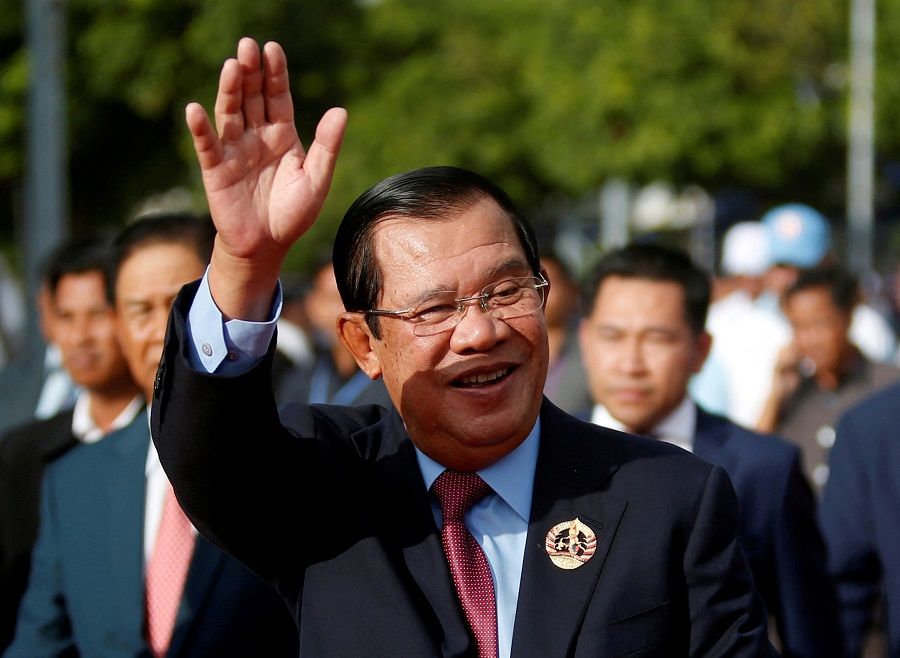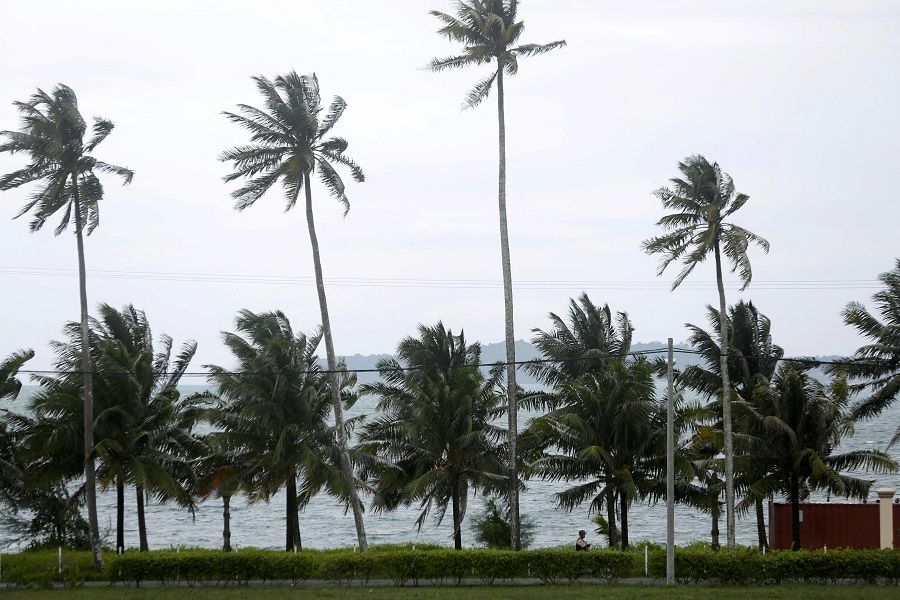Why Cambodia is leaning towards China and not the US

Material things such as power and balance of power in realist theories play an important role in explaining a state's foreign policy. However, they have little significance for a small authoritarian state like Cambodia, especially in explaining Cambodia's foreign policy towards the US and China. The ruling elite's ideas and perceptions matter most in driving Cambodia's relations with these two powerful nations.
Cambodia's elite have the notion that the US is a threat to Cambodia's regime while China is supportive of it. Consequently, Cambodia's foreign policy tilts towards the latter rather than the former.
Such a notion is driven by the US's past involvement in Cambodia's domestic affairs and its efforts to end the Cambodian regime. The US has threatened the survival of the Cambodian regime on two fronts.
Firstly, it has sought to strengthen the democratic system in Cambodia via civic education and grassroots engagement. The National Democratic Institute (NDI) is an example of a US-funded democracy-building vehicle in Cambodia. NDI needed around US$2 million a year to keep running in the five years prior to its forced closure in 2017.
US perceived as a troublemaker for the Cambodian regime
Moreover, the US strongly supports Cambodia's opposition parties and independent media. Washington-backed media in Cambodia include Radio Free Asia (RFA), Voice of Democracy, Voice of America Khmer and the Cambodia Daily. These media outlets contributed largely to the ruling party losing popularity by discussing corruption, land disputes, human rights violations and other sensitive issues.

The US had previously lent great support to the Cambodia National Rescue Party (CNRP), Cambodia's erstwhile main opposition party which has since been banned. For instance, when CNRP leader Sam Rainsy could not participate in the 2013 national election as he was living in exile after alleged politically motivated charges were brought against him, members of the US State Department and the US Congress pressed the Cambodian government on the issue. Days after this intervention, Rainsy received a royal pardon from the king and was allowed to return to Cambodia.
With US backing, the CNRP was able to exploit the underperformance and corruption of the Cambodia People's Party (CPP)-led government while promising to tackle these existing unaddressed problems if CNRP won the election. The campaign went so well that CNRP received overwhelming support in the 2013 national election. As a result, the CNRP secured 55 seats compared to the CPP's 68, which meant that CNRP had nearly defeated the ruling party. CPP secured a victory but it paved the way for the CNRP to gain influence in the National Assembly.
Secondly, the US put Cambodia under great international scrutiny and pressure for deviating from democratic practices. In the two decades between 1997 and 2021, the US has suspended its aid assistance to Cambodia on numerous occasions in the name of "democratic practices" or the lack thereof.
In addition, the 1997 armed conflict in Phnom Penh led to Cambodia being isolated from the outside (read: Western) world. The US publicly denounced Hun Sen as it withdrew US$25 million of aid assistance from Cambodia. On top of that, the US redirected its funds of US$5 million from Hun Sen's government to Norodom Ranariddh of the royalist Funcinpec party and Sam Rainsy, who was escaping to Thailand. In 2010, the US again suspended its military assistance of 200 military trucks to Cambodia in response to Cambodia's repatriation of ethnic Uighurs to China.
The US's hard approach only serves to create distance between itself and Cambodia. In contrast, China is perceived as a more favourable partner as it offers Cambodia much-needed infrastructure funding.

After that, however, the heated relations between the US and Hun Sen's government seemed to cool down. But this did not continue for long due to the dissolution of CNRP, and poor relations between the US and Cambodia resumed.
In February 2018, the US cut US$8.3 million worth of aid after Cambodia's national election. Not only that, the US imposed sanctions on Cambodia's senior government officials by freezing their assets and banning travel to the US. The US's actions were believed to be aimed at putting pressure on the CPP-led government to respect human rights and democracy.
China uses the carrot rather than the stick
The US's hard approach only serves to create distance between itself and Cambodia. In contrast, China is perceived as a more favourable partner as it offers Cambodia much-needed infrastructure funding. Since 1997, China has always stepped up to fill the vacuum whenever Cambodia was left on the wayside.
Immediately after the 1997 armed conflict, instead of putting pressure on Cambodia and ending its aid as the US did, China provided assistance worth US$6 million to Cambodia, according to a RFA timeline. Six months later, it provided a loan worth US$2.8 million. China's actions earned it trust among the CPP leadership. In 1999, China provided US$18 million in foreign assistance and US$200 million in non-interest loans to Cambodia.
China's response to the Cambodian court's decision to dissolve CNRP was different from the US's as well. China supported Cambodia's approach to handling its domestic affairs as its Ministry of Foreign Affairs stated that "China supports the Cambodian side's efforts to protect political stability and achieve economic development, and believes the Cambodian government can lead the people to deal with domestic and foreign challenges".
Moreover, China also contributed funds and equipment to assist Cambodia in its 2018 elections while the US and EU cut their funding citing the dissolution of CNRP. These actions made Cambodia's regime more comfortable with China.
... from around five years ago, Cambodia started limiting its engagement with the US.

Despite having close relations with China and the US's constant harping on human rights and democratic improvement from Cambodia, prior to 2017, Cambodia was active in engaging with the US. For instance, in 2010, Cambodia hosted its first Angkor Sentinel, an annual bilateral military exercise between Cambodia and the US, with the aim of assisting humanitarian assistance.
The lure of Chinese investments
However, from around five years ago, Cambodia started limiting its engagement with the US. The Angkor Sentinel, perceived as an instrument for building the military relations between the two countries, was called off in 2017. Incidentally, a Cambodia-China military exercise known as the Golden Dragon kicked off in 2016, a few months before the suspension of the Angkor Sentinel. Notably, the military drill has continued and was still conducted in 2020 despite the Covid-19 pandemic, although it was halted in 2021. This shows the strong bond of Cambodia-China relations.
On top of that, some popular US-supported media such as RFA and Cambodia Daily were forced simultaneously by the Cambodian government to shut down in 2017. This can be seen as a move to curb the US influence in Cambodia.
It is important to emphasise the causes of Cambodia's estrangement from the US in 2018. Firstly, Cambodia's ruling party secured its position in Cambodia's domestic politics by successfully pushing CNRP, its major rival and the only viable opposition party out of the political ring. Khem Sokha, a president of CNRP was placed under house arrest while Sam Rainsy along with senior CNRP members had earlier gone into exile in France.
... concerns about regime survival have limited Cambodia's room for manoeuvre in its foreign policy, particularly where it concerns balancing its relations with the US and China.

Secondly, China appeared to be a reliable external partner who proved its worth through its previous engagement. Chinese aid and assistance to Cambodia helped to weaken Cambodia's reliance on traditional donors, thus, reducing the impact of the US's hard approach.
Furthermore, China became the viable source of Cambodia's foreign direct investment, loan and foreign assistance especially as the latter started initiating its Belt and Road Initiative (BRI). Being a supporter of BRI, Cambodia is expected to gain substantial economic benefits from it. During the first Belt and Road Forum in Beijing in 2017, China granted US$240 million to Cambodia and signed 13 agreements under the BRI framework that focus on trade, maritime cooperation, and infrastructure development.
By embracing bandwagoning toward China, the Cambodian regime can better fend off internal and external voices pushing for greater democracy in Cambodia.
Later, at the second BRI in 2019, Cambodia also signed six agreements with China focusing on investment and exports. The project would also help Cambodia build more infrastructure, particularly roads, bridges and ports. Over the years, China has provided around US$3 billion in concessional loans for road and bridge construction.
Furthermore, China also funded Cambodia's port expansion and airport projects such as the port in Sihanoukville and the Ream Naval Base, as well as the airports in Siem Reap and Phnom Penh. Such infrastructure projects are very significant for the Kingdom to boost its export and attract foreign investors.
All in all, concerns about regime survival have limited Cambodia's room for manoeuvre in its foreign policy, particularly where it concerns balancing its relations with the US and China. While many argue that Cambodia should adopt a hedging strategy as this would give Cambodia more options, its domestic politics dominated by regime survival would prevent it from doing so. By embracing bandwagoning toward China, the Cambodian regime can better fend off internal and external voices pushing for greater democracy in Cambodia.
